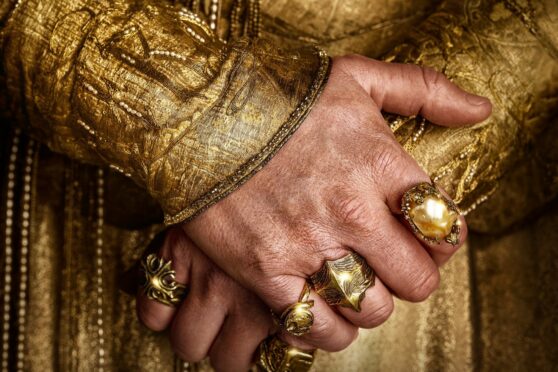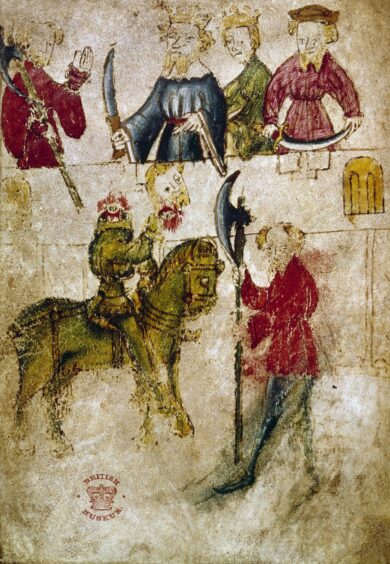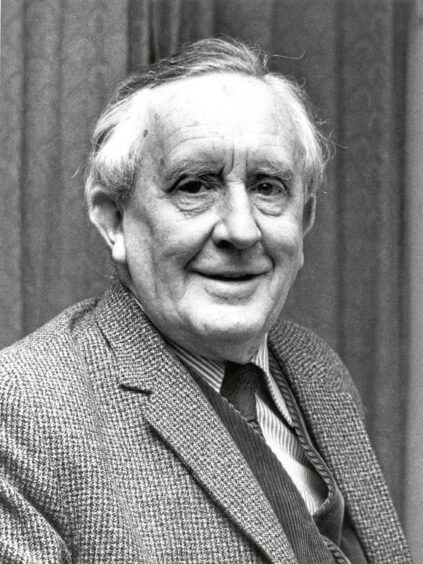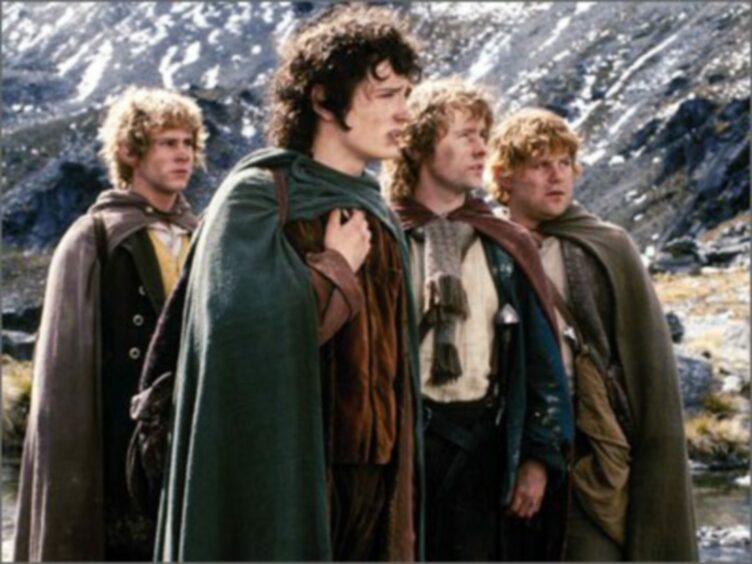
Powerful elves, dragons, wizards and plucky hobbits on quests ending in a battle between good and evil have become stars of popular culture since JRR Tolkien’s The Lord Of The Rings and The Hobbit became some of the bestselling books of all time and were turned into Hollywood blockbusters.
They have inspired countless other films, television dramas, books, graphic novels and computer games, from Terry Pratchett’s Discworld and Philip Pullman’s His Dark Materials to George RR Martin’s Game Of Thrones.
But we would have none of these fantastical worlds set in fictional pre-history without medieval tales such as Sir Gawain And The Green Knight.
Tolkien’s links to Scotland – and how the late-14th-Century poem inspired him – will be celebrated with a special lecture next month given by a panel of world-leading experts on the “father of modern fantasy literature” to mark the 70th anniversary of the author’s visit to the University of Glasgow.
Sir Gawain And The Green Knight was an Arthurian tale in which the hero encountered an array of supernatural creatures. It inspired Tolkien to create Middle-earth, a realm threatened by orcs and ringwraiths serving the necromancer Sauron, whose future lay in the hands of a fellowship of hobbits, elves, men and dwarves.
Tolkien published The Hobbit to critical acclaim in 1937 and, in 1953, he was on the cusp of bringing out the first volume of The Lord Of The Rings.His popularity as a fantasy writer was on the rise, and the Oxford don was invited to give a lecture to the University of Glasgow. In a handwritten letter – still held in the university’s archives – Tolkien asked if he could talk about Sir Gawain And The Green Knight, which he had edited and translated.
His lecture was published posthumously in 1983 in The Monsters And The Critics And Other Essays which was edited by his son, Christopher.
Dr Dimitra Fimi, senior lecturer in fantasy and children’s literature at the University of Glasgow and co-director of the Centre for Fantasy and the Fantastic, said: “It was a thrill to discover more about Tolkien’s lecture at Glasgow and this fascinating connection to the city.
“Today, 70 years later at the University of Glasgow, his own work is on the curriculum of our fantasy MLitt programme and we have various PhD students working on Tolkien.”
Dr Andoni Cossio, postdoctoral fellow at the Centre for Fantasy and the Fantastic, said: “As a schoolboy, Tolkien had a great affection for Sir Gawain And The Green Knight, which even led to occasional recitations of certain passages for his friends.
“By the time of the Glasgow lecture, Tolkien had a deep knowledge of the poem that he put to good use in his university teaching, supervision and lectures. Tolkien had also prepared and published an edition of Sir Gawain And The Green Knight in 1925, together with his colleague, EV Gordon, which remains an important textbook for students studying the poem and helped establish it as a canonical text in medieval studies. During his 1953 WP Ker lecture, Tolkien quoted from his own Sir Gawain translation, which was later broadcast by the BBC.”
Sir Gawain And The Green Knight is a 2,530-line, anonymous poem. It is set in the legendary court of King Arthur. The poem opens with a description of a Christmas feast at Camelot when a mysterious green knight arrives and challenges the crowd to a bizarre game, which Gawain accepts, leading to the virtuous young knight facing a series of trials and temptations.
“The poem has similar themes to those found in Tolkien’s works,” said Cossio. “His Glasgow lecture was mainly about the third ‘fitt’, or section, where Gawain is tempted by the lady of a castle, and that is reflected in the Lothlórien episode of The Lord Of The Rings.”
This is when Frodo offers the One Ring to Lady Galadriel, who is tempted but refuses, realising she would be corrupted and become a Dark Queen in place of the Dark Lord.
“The temptation is sexual in Sir Gawain And The Green Knight but Tolkien has portrayed it as the temptation of power,” added Fimi. “Tolkien turns it around in The Lord Of The Rings.
“Instead of a fairy or sorcerer woman – Morgan Le Fay in disguise – tempting Sir Gawain, it is a male Frodo tempting a fairy woman. Like the fairy people in medieval texts, the elves are ambiguous and they can be quite dangerous, playing on human desires.
“Tolkien drew on a wealth of medieval sources to create Middle-earth and you can see themes such as the forest as a liminal space where weird, magical and slightly dangerous things happen. The Old Forest is a primeval, untamed space outside human control filled with powerful magic.”
Fimi also (spoiler warning) points to a similarity in the endings of The Lord Of The Rings and Sir Gawain And The Green Knight, where the heroes ultimately fail in their quest. Frodo doesn’t want to throw the ring into Mount Doom, and Sir Gawain cheats by secretly wearing a magical girdle that will keep him alive during the beheading trial with the Green Knight.
Both Frodo and Sir Gawain are wounded in the process – Frodo when Gollum bites off his ring finger and Sir Gawain when the Green Knight nicks his neck as punishment – and their triumph is tainted by shame.
“The Lord Of The Rings ending also reflects ideas from the Arthurian legends,” adds Dr Fimi.
King Arthur is taken to the magical island of Avalon to recover from his battle wounds and await his return as the “once and future king”. Frodo is also wounded, and leaves on an elven ship with Gandalf and Bilbo Baggins to the Undying Lands, or Valinor, a realm outside Middle-earth that only welcomes ring-bearers and immortals, where he can be healed. “Christopher Tolkien talked about the ending as Arthurian. What is Valinor or Avalon? Is it paradise, the afterlife, or is it a real place? It is quite ambivalent,” said Fimi.
Several scholars have recognised Sir Gawain And The Green Knight as a source of inspiration for Tolkien, with some suggesting the Green Knight influenced the characters Treebeard, the oldest of the ents, and Tom Bombadil, the mysterious and ancient forest-dweller.
“The wodwos or forest trolls mentioned in Sir Gawain and the Green Knight inspired Tolkien to create the woses, the wild men of the woods, but where they are fleetingly mentioned in the poem, Tolkien develops the incident,” said Cossio. “Besides nature writing, forests tend to become mere backdrops in contemporary literary works, which tend to favour urban environments.
“However, in fantasy, a genre heavily indebted to and evocative of the liminal forest of medieval romance, the ubiquitous portrayal of wooded areas has turned them into a hallmark of the genre.
“The works of Tolkien, and fantasy more broadly, recover and rediscover forests with their rich, enjoyable and naturally rooted stories that allow modern humans to value and understand these spaces.”
Without Tolkien’s legacy and the acclaimed Peter Jackson films of his best-known novels, the likes of Old English poem Beowulf – made into a film featuring Anthony Hopkins and Robin Wright in 2007 – and Sir Gawain And The Green Knight, which became the 2021 movie The Green Knight starring Dev Patel – would have been confined to the realm of academia. Instead, Tolkien helped bring these myths and tales to a wider audience.
“Tolkien is the father of fantasy as we understand it today,” said Fimi. “There were authors before him who created magical worlds such as JM Barrie and George MacDonald, but nobody called their work fantasy fiction.
“Tolkien became a publishing phenomenon and made fantasy a marketable genre. And now his work and that of other fantasy writers is being taken seriously by the academic world.”
How Hobbits achieved world domination
The Lord Of The Rings has captured imaginations all around the globe across the original novel, Hollywood blockbuster adaptations and a recent TV series.
Drawing on author JRR Tolkien’s knowledge of philology and folklore, and written in stages between 1937 and 1949, The Lord Of The Rings is one of the best-selling books ever written and is credited with starting and influencing the high fantasy genre.
Published in three volumes in 1954 and 1955, the story began as a sequel to Tolkien’s earlier book The Hobbit and is set in Middle-earth, a fictional world inhabited by various races including hobbits, dwarves, elves, wizards and humans.
The tale follows the journey of hobbit Frodo Baggins and his companions as they attempt to destroy the One Ring, a powerful artefact created by the Dark Lord Sauron that grants immense power to its bearer.
Director Peter Jackson adapted the novel into a series of three films, 2001’s The Fellowship Of The Ring, 2002’s The Two Towers and The Return Of The King the following year.
With a huge budget and an all-star cast including Ian McKellen, Cate Blanchett, Orlando Bloom and Liv Tyler, the films are among the highest-grossing of all time and won 17 Academy Awards out of 30 nominations.
More than 150 locations in New Zealand were used for filming, causing visitor numbers to grow by 40% in the early 2000s in a phenomenon labelled Tolkien Tourism.
More recently, the tales of Middle-earth preceding The Hobbit have been brought to life in Amazon Prime Video series The Lord Of The Rings: The Rings Of Power. The most expensive TV series ever made, it debuted in September 2022 to mixed reviews. A second series is due in 2024.
The Tolkien Sir Gawain lecture 70th anniversary event takes place at 5pm on Thursday, April 27 in the Joseph Black Building, University of Glasgow, where Tolkien held his lecture, or online. It is accompanied by an exhibition, including a hand-written letter by Tolkien

Enjoy the convenience of having The Sunday Post delivered as a digital ePaper straight to your smartphone, tablet or computer.
Subscribe for only £5.49 a month and enjoy all the benefits of the printed paper as a digital replica.
Subscribe © Granger/Shutterstock
© Granger/Shutterstock © Granger/Shutterstock
© Granger/Shutterstock